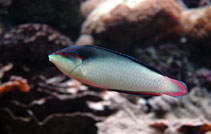| Family: |
Labridae (Wrasses), subfamily: Corinae |
| Max. size: |
20 cm SL (male/unsexed) |
| Environment: |
reef-associated; marine; depth range 4 - 30 m |
| Distribution: |
Western Pacific: Philippines and Taiwan to Fiji, north to the Izu Islands, south to the Great Barrier Reef and New Caledonia. Recently recorded from Tonga (Ref. 53797). |
| Diagnosis: |
Dorsal spines (total): 9-9; Dorsal soft rays (total): 11-13; Anal spines: 3-3; Anal soft rays: 11-13. Head spotted. Color of females black dorsally, blue spotted, becoming yellowish white on sides and white ventrally; opercle with a large black ocellus; anal fin with a broad black band. Male form blackish dorsally with light blue dots, shading gradually to light yellowish green; each body scale with vertical light blue line; upper half of head dark reddish with dark-edged blue bands radiating from eye; anal fins with several longitudinal bands on a broad orange zone; caudal fin with vertical stripes. Dorsal spines pungent. |
| Biology: |
An inshore species inhabiting shallow coral reefs (Ref. 9823), with patches of sand and rubble (Ref. 37816), also along upper part of slopes and on reef crests with Acropora corals. Adults occur in small loose groups of females with dominant male nearby. Juveniles occur solitary in corals (Ref. 48636). Feed on benthic invertebrates. Oviparous, distinct pairing during breeding (Ref. 205). Occasionally seen in fish markets and aquarium trade. |
| IUCN Red List Status: |
Least Concern (LC); Date assessed: 04 February 2009 Ref. (130435)
|
| Threat to humans: |
harmless |
Source and more info: www.fishbase.org. For personal, classroom, and other internal use only. Not for publication.

